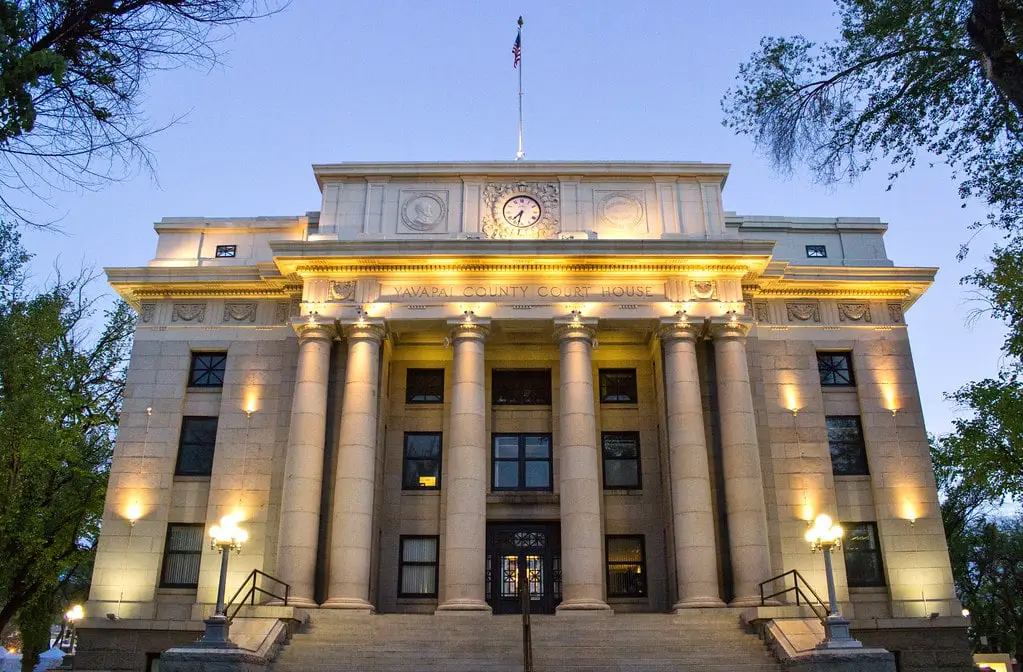Yavapai County Courthouse – The Early Days
During the mid-19th century, Yavapai County began by leasing a courtroom within a wooden two-story structure at the intersection of Gurley and Cortez streets in Prescott, Arizona. The first floor contained the jail, and the second housed county commissioner offices and meeting spaces.
Over time, this building underwent numerous transformations, and now it serves as a three-story Masonic Temple with a dentist’s office, jewelry store, and clothing boutique as tenants.
Eventually, the need for a new courthouse and jail arose, leading the board of supervisors to award a contract for its construction in the town center. Local woodworkers Wilson and Haskell secured the bid for $58,998 (equivalent to $1,155,500 today).
The First Courthouse’s Inception
The initial courthouse, completed on February 23, 1878, featured a basement, two levels of red brick, and a clock tower with a bell. George Waters from Maine built the Victorian edifice using Verde Valley sandstone on the ground level and local bricks on the top level.
A.S Haskell, the project’s contractor, admitted to almost going bankrupt upon its completion. The clock, accompanied by an 800-pound bell, was delivered via the Colorado River from Howard Watch Co in Boston, Massachusetts.
A fire damaged the courthouse in 1892 when rainwater mixed with lime in the basement. This prompted the board of supervisors to construct an $800 addition to the building that same year.
In 1895, a new octagonal bandstand worth $200 was built, just in time for the Fourth of July celebrations.
The 1900s: A Fresh Chapter for the Courthouse
Prescott’s community raised funds to erect a statue commemorating the Rough Rider heroes from the 1898 Spanish-American War. In 1908, braces were added to the clock tower to prevent swaying and unintentional bell ringing. President Taft visited the decorated courthouse in 1909.
In 1910, a two-basin fountain with a statue was installed, and a Deodar Cedar tree was planted in the plaza’s northeast quadrant to celebrate Arizona’s statehood. The Boy Scouts positioned a plaque on a granite rock before the tree, dubbing it the “Arizona Statehood Tree.”
Constructing the Current Courthouse
With Arizona’s statehood official in 1912, Yavapai County set out to build a new courthouse. On February 16, 1916, the board of supervisors approved the building plans from W.N. Bowan of Denver, Colorado. Construction on the new courthouse began in October 1916 after the cornerstone was laid.
Italian stonemasons quarried the granite for the new Neoclassical Revival structure. With new sidewalks in place, the courthouse was completed in September 1918. New York Mayor Fiorello La Guardia visited and delivered a speech on the courthouse steps in 1938.

The La Guardia Bridge now bears his name. In 1954, the Business and Professional Women organized the first courthouse lighting. Senator Barry Goldwater announced his presidential candidacy from the courthouse steps in 1964.
USA Quiz
How many questions would you like?
Public restrooms were added under the western stairs in 1971 to accommodate the growing population and plaza events. The Yavapai County Courthouse was listed on the National Register of Historic Places in 1977.
After a winter freeze, the 1910 fountain was removed, and the “Lady Ermintrude” statue was donated to the Sharlot Hall Museum. In 1986, the Prescott Kiwanis Club contributed a new centerpiece for the fountain. The All-Veterans Memorial was added to the west side of the plaza in 1989, along with a “Cowboy At Rest” statue on the plaza’s south side.

The 2000s and Beyond
In 2000, presidential candidate George W. Bush visited the Prescott Courthouse. In 2008, presidential hopeful John McCain made the courthouse his sole campaign stop in his home state of Arizona. Consequently, the American Planning Association named the Yavapai County Courthouse one of America’s Top 10 Public Places.
County officials located the surviving “Lady Ermintrude” fountain pieces and initiated a restoration project. An Alabama foundry possessing the original statue pattern was commissioned, and they recast the missing and damaged parts.
For restoring the Historic Yavapai County Courthouse Plaza “Lady Ermintrude” Fountain, the National Association of Counties (NACO) granted Yavapai County a National Achievements Award in the Arts, Culture, and Historic Preservation category. The re-dedication ceremony for the fountain took place on June 29, 2018.

The Neoclassical Revival Architecture
Prominent from 1895 to 1950, the Neoclassical Revival Style is characterized by 1/2.5-story buildings, side-gabled or hipped medium-pitched roofs, boxed eaves with moderate overhangs, decorative door surrounds, porch balustrades, and various window configurations, including paired, triple, bayed, or arched.
The Neoclassical Revival style gained popularity following the 1893 Columbian World Exposition in Chicago and the creation of the “White City.” Renowned architects designed classically inspired buildings to house the fair’s exhibits, illuminated at night with strings of electric lights.
This influenced a generation of builders and architects. While used for residences, the style was more prevalent for public buildings and banks that required a sense of gravitas.

In Conclusion
The Yavapai County Courthouse, with its rich history and stunning Neoclassical Revival architecture, stands as a symbol of Prescott, Arizona’s heritage. Its progression over the years mirrors the growth and development of the community it serves.
From its humble beginnings in the 1800s, through various renovations and additions, to its current standing as one of America’s Top 10 Public Places, the courthouse remains an iconic landmark in downtown Prescott.
Visitors and residents can appreciate the Yavapai County Courthouse’s architectural beauty and the significant events and moments on its grounds.
Symbolizing the community’s resilience, progress, and pride, the Yavapai County Courthouse serves as a testament to the past while looking forward to the future.

